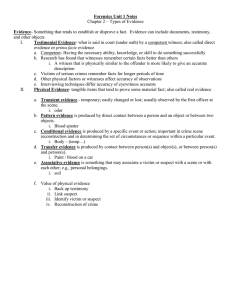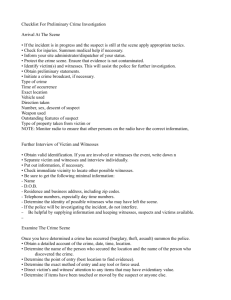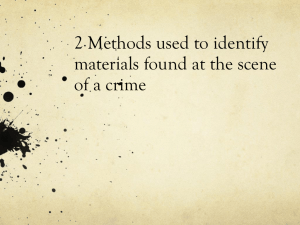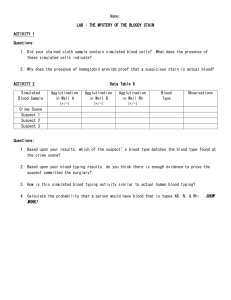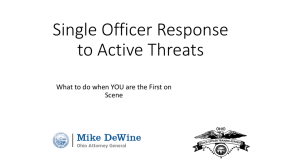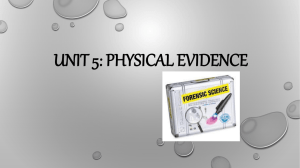CH 9 Powerpoint - Sierra College Administration of Justice
advertisement
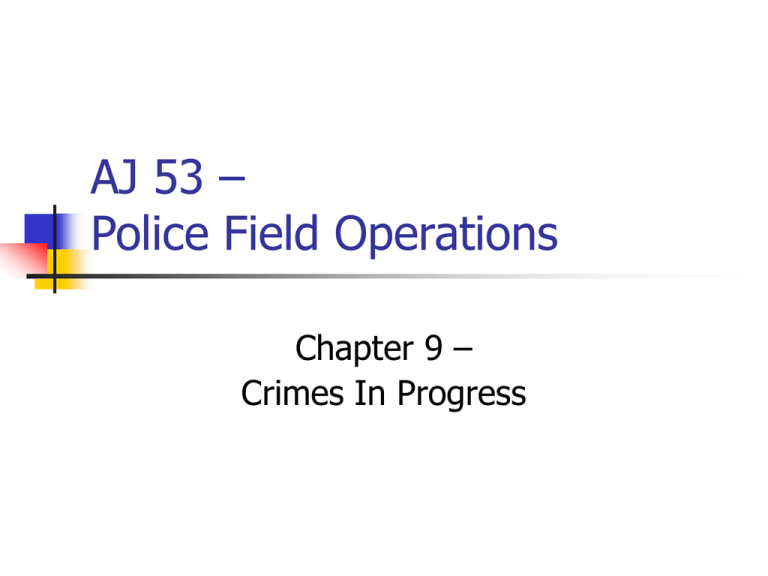
AJ 53 – Police Field Operations Chapter 9 – Crimes In Progress In-Progress Calls Require Immediate & Coordinated Response Potential for injuries/death Victim as well as responding officers Suspect identification/apprehension Multiple officers, clear communications How far can they get away? Evidence identification/preservation Crime-scene protection Pre-Planning When is an in-progress crime likely to occur? Any time of day/any day of week! Beat knowledge is crucial Potential victims/target locations Avenues of ingress & egress Ability to navigate safely in darkness Dead ends, one-way streets, etc. In vehicle, on foot, etc. High-ground observation locations Potential informants/witnesses Play the “What-If?” game with yourself! Dispatcher Responsibilities Obtain as much information from RP as possible as quickly as possible Relay information to responding officers as quickly as possible Keep the victim/RP on the line Questions to ask… What happened? Still happening now? Exact location? Injuries? How severe? Suspect(s) location? Identification/Description? Weapons? Location now? Vehicle? Direction of travel? Field Unit Response Beat knowledge is crucial! Code 3 vs. Silent Approach? Street directions, numbering system, etc. Each has advantages/disadvantages Know/follow department policy! Be aware of surroundings en-route Suspects, victims, witnesses, etc. Suspect’s appearance may have changed! Note suspicious/out-of-place vehicles, persons… Arrival at the Scene Communications How should you arrive? Siren? Silent? Stealthy? Where should you park? Dispatch, other officers, supervisors Safe, practical distance from scene Approaching on foot Use of cover and concealment What’s the difference? Arrival Considerations (cont’d) Stop and Observe… Don’t just barge in! John Wayne Syndrome Look & listen to determine what’s occurring Maintain Communications Consider requesting clear frequency Essential radio traffic only! Does Dispatch still have RP on telephone? If not, have Dispatch re-contact before entry Have parties come out to you, if possible Making Contact Safe approach/stance at doorway Knock and Notice, as required Exigent circumstances exception Take control of people and scene Identify persons involved Victim, suspect, RP, witnesses, etc. Security check of area Check for injuries/medical needs Separate and interview Crimes Against Persons and Violent Crimes Safe response, arrival, and approach Wait for back-up as appropriate Observe and gather intelligence Active-shooter situation? Public/Officer/Victim safety Display of weapons upon approach? May have to make entry/stop threat as soon as sufficient officers arrive Situational awareness Eyes/ears/senses on high alert Crimes Against Property Audible vs. Silent alarms Safe approach to scene How does this affect your response? Use of weapons? Communicate/Coordinate assistance Assess nearby persons/vehicles Suspects, lookouts, etc. Remember to look up! Building Entry and Searches Observe exterior Open doors, windows, etc. Signs of forced entry/attempted entry Identify/preserve potential evidence Officers enter/search together Avoids mis-identification, crossfire, etc. Silence/stealth vs. Making your presence known Radios, cell phones, keys, etc. make a lot of noise Maintain communications updates Building Searches (continued) Flashlights Communication with fellow officers Radio, talking, hand signals Room-by-room searches Day shift? How to hold/use during search Don’t linger in doorways Locked doors? Potential hiding places Expect the unexpected! Mentally/physically prepared to find suspects Use of Weapon During Search What else will you need to do with your hands during search? Which, if any, weapon do you choose? Handgun? Shotgun? AR-15? Taser? Other? Department Policy and common sense should guide your decision Advantages & Disadvantages to each… Open/close/secure doors, Manipulate light switches, Use radio Ease of carry, slings, one-hand/two-hand, etc. Firepower/penetration Transition between force options Always follow basic safety rules Trigger finger indexed along slide/frame Muzzle pointed in safe direction Avoid crossfire situations Be aware of target and beyond Prowler Calls 647(h) PC – Prowling (M) 647(i) PC – Peeping (M) Loiter, prowl, wander on private property, day or night, without lawful business Peek in door or window of inhabited building/structure while prowling Prowler characteristics vary greatly… No crime – resident, friend, relative, etc. Curious teens Domestic Violence, Stalking, Sexual Voyeur Rapist/Sexual Predator, Serial Killer Responding to Prowler Calls Response and Approach Silent/blacked-out response Park a few houses away Silent approach on foot Be aware of vehicles/pedestrians in area Use light to thoroughly search area when practicable Weapon drawn during search? Not as likely for misdemeanor response Contacting the victim Very traumatic situation, especially if UTL suspect Thoroughly check interior/exterior Assist with alternate overnight arrangements Remain in area to observe stealthily Extra-patrol follow-up General Response Considerations Avoid caravanning to scene Don’t jump-in on the call unless assigned or requested Consider alternate routes to/from location Drift closer, but stay available Acquire good location for BOL surveillance Suspect’s mode of travel? Time elapsed since crime reported? Distance able to be covered in that time? General Search Considerations Each search has certain advantages/disadvantages… Foot Search Spot Cover Leapfrog, Quadrant, Spiral, Zigzag Plainclothes Assistance Fixed-location surveillance Various search patterns Face-to-face interaction/question witnesses Limited mobility, response time, equipment Proper ID and clear communications! Alternative Search Methods Bicycles, Air Units, Mounted Units, etc.
